If you want to see smartphone innovation, you head to the premium end of the phone market, where foldables contest with phones that want to be DLSRs or gaming phones. The biggest and smartest features always debut there, with price points that can leave your wallet gasping.
But if you want to see where the real competition is in the smartphone world, you’ve got to head to the mid-range space. This is where the features that were once new and shiny trickle down from premium to offer some of the best value smartphone experiences.
It is a brutal arena for phones where the likes of Samsung, Oppo, TCL, Google (just, though I’m still annoyed about the Pixel 8a’s price hike) and Motorola battle it out. Even Apple has a play in the mid-range via the iPhone SE, and it is a brand that actively avoids being seen as “cheap”.
Enter the Nothing Phone 2a.
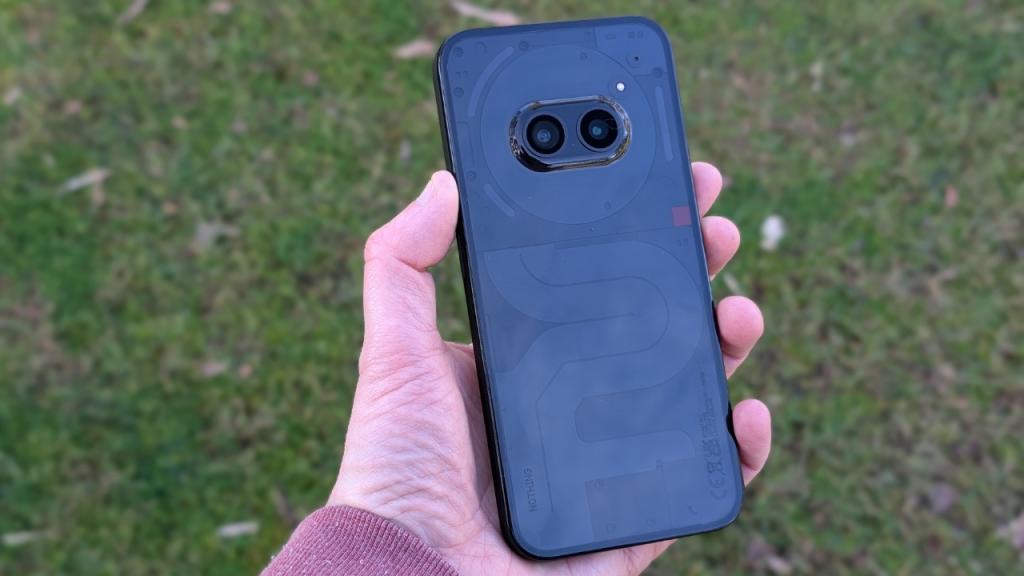
Nothing as a phone brand isn’t new, but it is relatively new as an easily available phone brand here in Australia, with JB Hi-Fi only signing on to sell the Nothing Phone 2a and its bigger sibling, the Nothing Phone 2 a few months ago.
With pricing starting at $529 for the 128GB model (as tested) or $599 for the 256GB variant, the Nothing Phone 2a distinctly sits in that mid-range market, although it’s very much towards the lower (and therefore more affordable) end of it.
However, while most phones at that price space tend to look ordinary, the Nothing Phone 2a is a bit of an eye-catcher or depending on your tastes, an eyesore.
It’s all quite normal at the front, with a 6.7 inch 2412×1084 pixel AMOLED display topped with a hole punch for the front-facing camera. That’s slightly underselling it; you’re also staring at a display that’ll manage 30Hz-120Hz dynamically, or at fixed 60Hz or 120Hz rates depending on your preferences.
That’s not best in class as you’d see in the premium space, but it’s a touch more than the standard 60Hz or sometimes 60-120Hz that most mid-range phones offer. Bezels are minimal and fade nicely into the black frame on the reviewed model, though they’d be a tad more obvious on the Milk (White) model, I suspect.
It’s when you flip the Nothing Phone 2a around that you see its big design selling points. The back of the Nothing Phone 2a is plastic, and a bit of a fingerprint magnet with it, but that’s more obvious because the back is transparent.
The Milk and Special Edition versions show this off a lot, while the smoky dark plastic of the black edition makes it a lot more subtle, outside of a single red square. I like the more subtle look, honestly, because it gives you an interior tech glimpse without being wholly in your face like the RedMagic 9 Pro.
Light up my world (for a few days)
Equally, I can see it being divisive as a design element, though you could always cover it with a case if it bothered you. Do that with anything but a clear case – there’s an official one you can buy plus third-party options, but no case in the Nothing Phone 2a’s slender retail box – and you’d cover over Nothing’s big unique selling point, its Glyph interface.
On the Nothing Phone 2a this takes the form of a series of LED strips that can light up for notifications, show you volume raising on the phone or even track the relative proximity of an Uber if you give the app permission to do so. It also acts as a fill light if you allow it to do so for photos and videos.
There was a period – I want to say it was about a decade or more ago – where nearly every Android maker was rushing to throw notification lights on their phones – HTC absolutely loved them back in the day when HTC was significantly more relevant as a consumer phone maker – but few went quite as far as Nothing has done. The Glyph lights on the Nothing Phone 2a are more subdued than on its other phones, but using them over a few days reminded me why so many makers essentially dropped them.
They’re a cute gimmick for sure, but like most gimmicks they’ve got a distinct shelf life. Yes, you can use the glyphs to show the volume on the phone going up or down, but how often do you want to do that when you’re only looking at the back of the phone? Setting them to pulse to music is cute for a little while, but the size of the lighting means you’d create the world’s smallest and, I suspect loneliest dance floor if all you had was the Nothing Phone 2a.
The Nothing Phone 2a is IP54 certified, which essentially means that it should be ok with a little light rainfall, but it’ll probably die if you drop it in the toilet. Try to avoid that whenever possible.
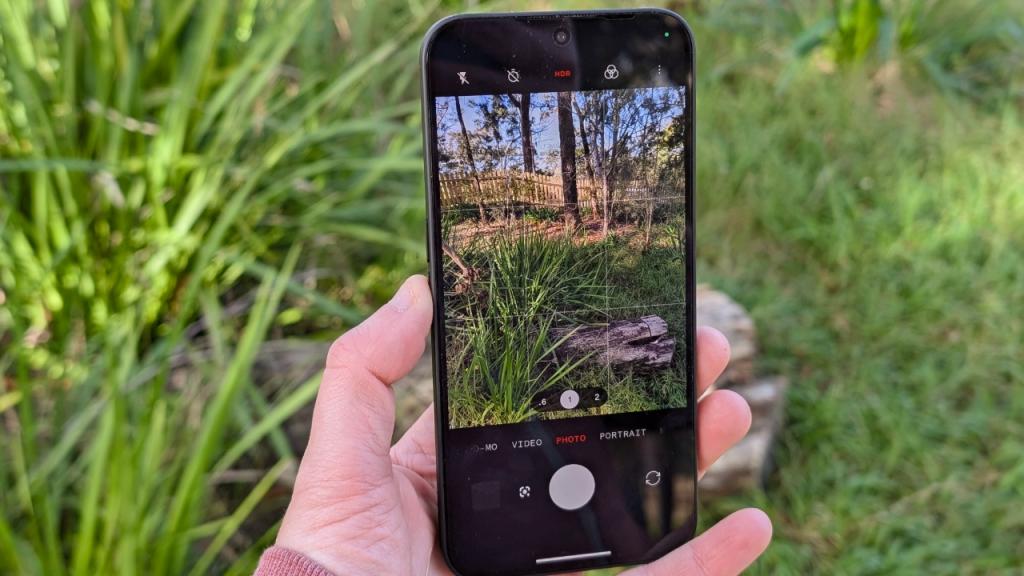
Mid-range cameras are good (for a few tasks)
The Nothing Phone 2a features dual 50MP rear cameras (wide and 114˚ ultra-wide) that sit sternly in the rear middle of the phone, while the front-facing hole punch houses a 32MP selfie shooter.
The practical reality for most mid-range phones of late is that they’ve been decent for most regular everyday tasks, but the phones that were good for their money were few and far between, especially once you got into trickier shots in lower light or with more motion.
The Nothing Phone 2a shoots well enough in most circumstances, maybe even a little above my expectations for still shots.
Let’s take that Glyph fill light, for example. On a regular mid-range phone you’d be looking at either a single bright LED flash, which can freeze subjects but also gives that classic (but unwanted) glare look, or no flash at all.
Experimentally, I grabbed my knitted Godzilla (what, you don’t have one?) and dropped him on a sofa in a poorly lit room where you might want to use flash to enhance a shot.
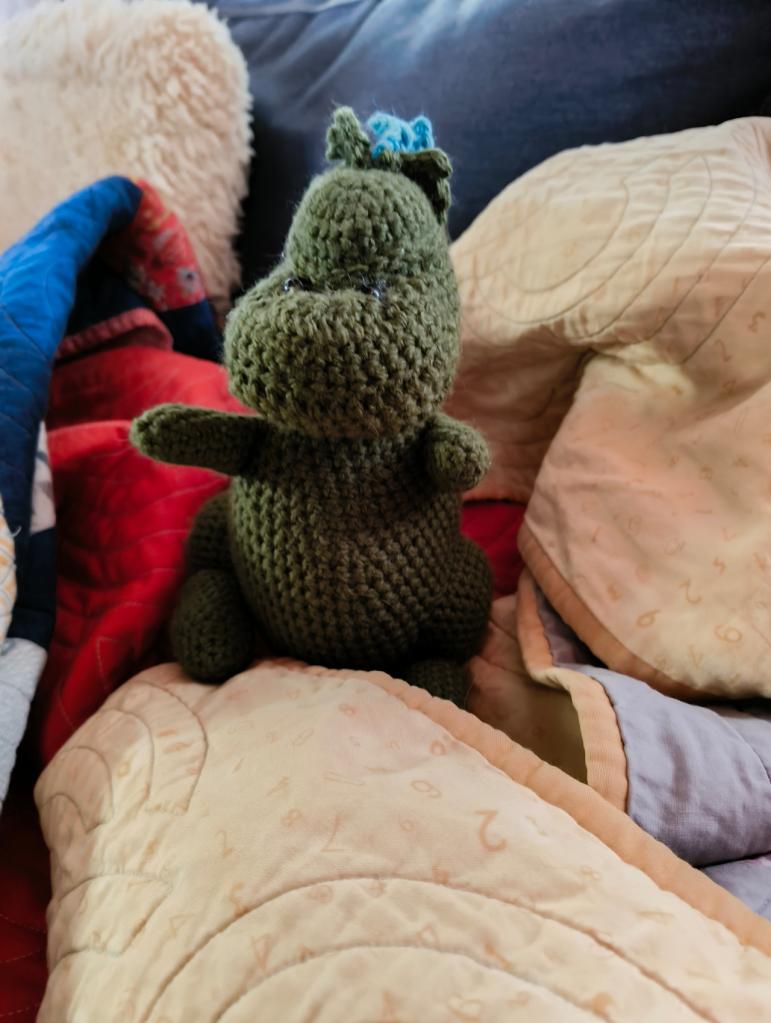

You’re not going to be able to use the Glyph fill light without your subject being aware of it of course, and a regular flash is also available for shots where the fill light (which isn’t as bright and therefore as harsh) might not cover an area properly.
Like so many other mid-range phones, what you don’t get with the Nothing Phone 2a is any kind of actual telephoto lens, instead relying on digital cropping at a default of 2x, though you can push it up to 10x if you’re determined to get photos not worth taking.

Nothing’s default camera app is a deliberately cut-down affair visually, which may appeal to those who don’t want complex controls, though if you dig around you can push it into its expert mode to get a little more fine-tuned control.
While stills are decent – I’d strongly argue the best mid-range phone for photos you can buy right now (if you can still find one) would be Google’s Pixel 7a – the same sadly can’t be said of video. In ideal outdoor conditions it’s fine, but any kind of challenging light or exposure situation quickly saw the Nothing Phone 2a’s video output struggle, and not by a small amount.
Here are some more sample images.



Surprisingly powerful, though Nothing OS isn’t to my taste
Under the display of the Nothing Phone 2a you’ll find a MediaTek Dimensity 7200 Pro, paired up (for Australian models) with 8GB of onboard RAM and either 128GB or 256GB of storage. Nothing does make a 12GB RAM model of the Nothing Phone 2a, and if you’re buying online it’d be worth checking which model you’re being offered – but the official Australian model is the slightly lower-RAM variant.
There was a time when I’d groan when faced with a phone running MediaTek silicon, because while it was low-cost and therefore budget-friendly, that was because it was nearly always crap in the performance stakes. That’s not been the case with its Dimensity line, however, where it’s generally performed quite well for its price against the best that Qualcomm or Samsung offer at these kinds of prices.
At the Nothing Phone 2a’s $529/$599 price point, you could opt for phones like the Samsung Galaxy A35 or the Oppo Reno11 F 5G, and at a comparative level, the benchmark picture for the Nothing Phone 2a is an interesting one.
It sits between the Samsung and the Oppo at a CPU level with Geekbench 6 CPU scores of 1124/2569 (Single/Multi-Core), though it’s nipping at the heels of the A35 there.
In GPU terms, using 3DMark’s Wild Life benchmark, it utterly annihilated the A35 and Reno11 F, managing a score of 4147; comparatively the A35 scored 2823 in that test while the Reno11 F managed 2239. That result did set off my bullshit-o-meter, fine-tuned over many years of testing, because benchmark juicing isn’t a new phenomenon.
However, other reviewed benchmarks do accord to mine, and in more real-world testing, the Nothing Phone 2a does do a decent job with Android gaming. It’s still a mid-range phone – don’t expect to be hitting the highest detail levels and refresh rates in Diablo Immortal, for example – but it’s a speedy customer relative to its price point. Rather predictably, while you can see its innards from the back, this doesn’t equate to better heat dissipation if you do opt for a lengthy gaming session, with the Nothing Phone 2a getting notably warm after extended gameplay use.
The Nothing Phone 2a runs on Android 14, with the promise of three years of OS upgrades and four years of security upgrades as standard. That’s slightly less than Samsung’s four OS upgrades, but it’s still all too common for mid-range phones, especially the cheaper ones to skip out on upgrade promises at all, so that’s quite pleasing to see.
Less pleasing – at least to me – is NothingOS, Nothing’s launcher that sits on top of Android. NothingOS is a deliberately stripped-down visual reworking of Android with monochromatic icons that lack icon text by default.
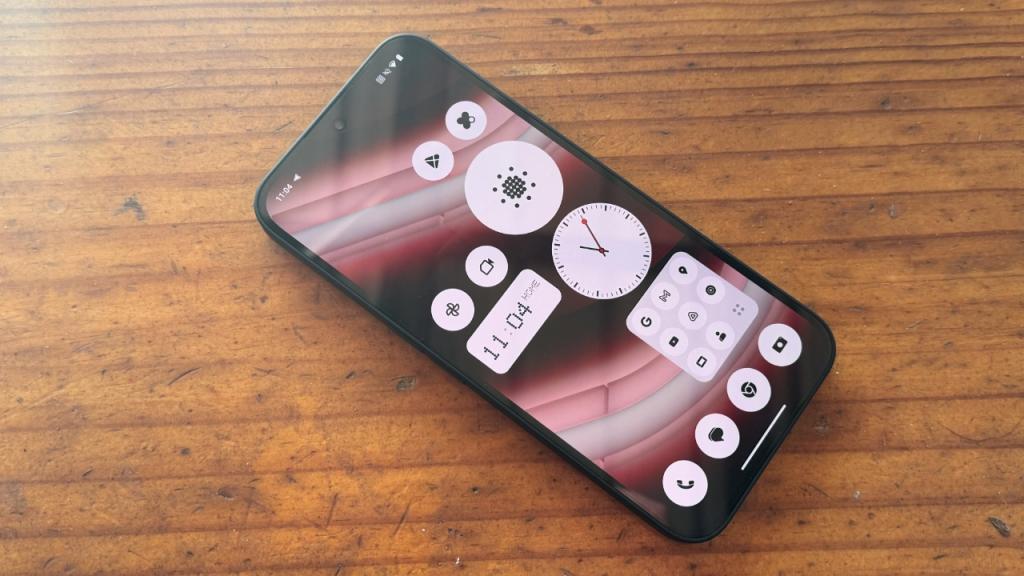
I get it, I do, a simple aesthetic isn’t cluttered and some may argue that having no colour on your icons might be a tad more eye-friendly to boot.
The problem is that it’s inconsistently applied; the default Google Apps and the very small number of apps that Nothing preinstalls for Glyph management and pairing its own headphones are all black, but it’s a bit of guesswork as to whether other installed apps will have colour or not.
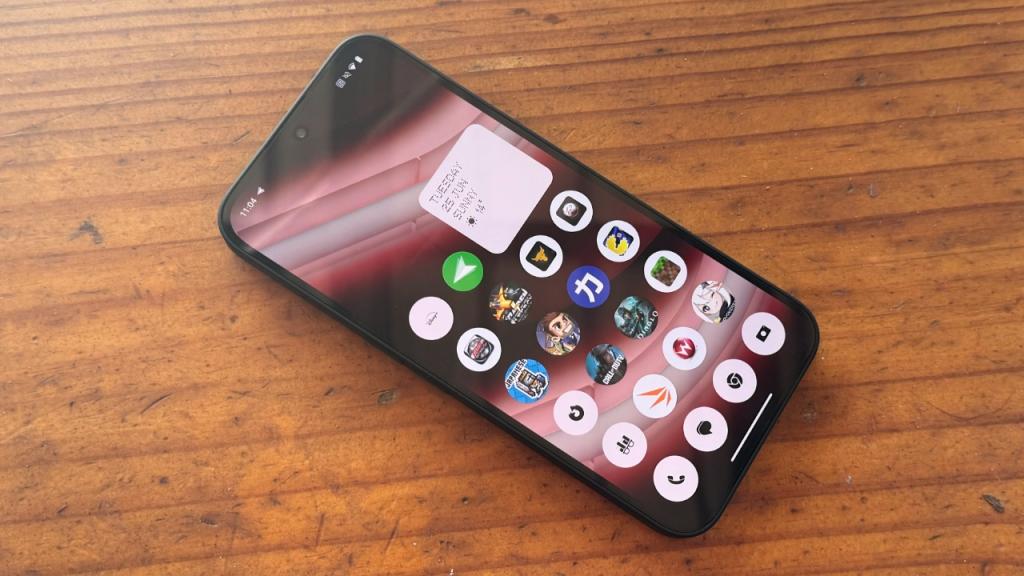
Also, unless you’re super familiar with the shapes of your app icons, you’ll probably struggle for a while to pick the right apps the first time.
You’re not stuck in this arrangement, thankfully. A long press on an empty part of the screen will bring up NothingOS’ customisation menu, where you can revert to colour icons and enable text app labels if you desire.
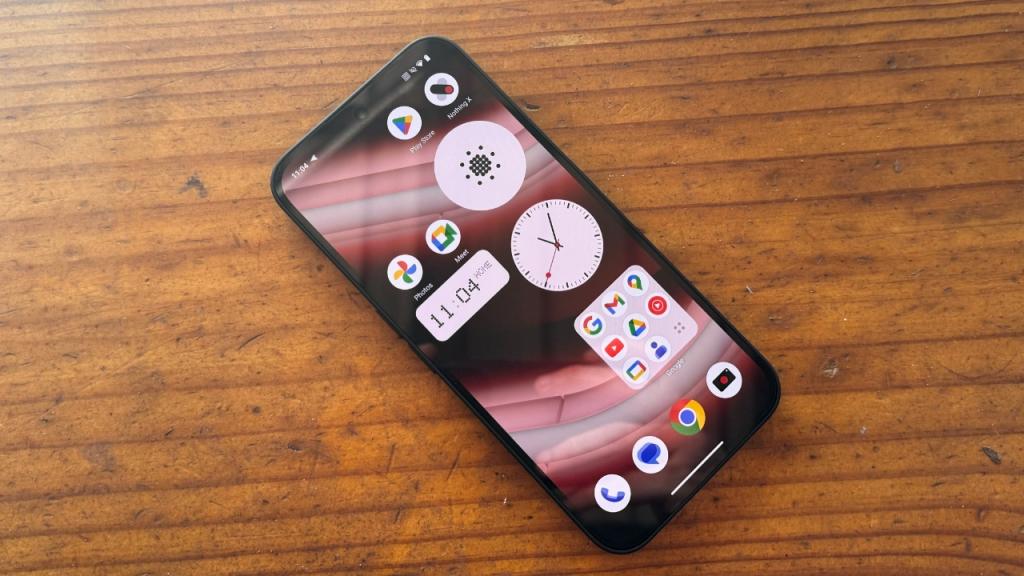
The Nothing Phone 2a is a 5G-capable phone (sub-6Ghz only), and during my review period testing around Sydney, I hit my usual standards for 5G coverage on the Telstra network, typically hitting between 200-400Mbps down with Speedtest. 5G coverage and network conditions almost always play more of a role in those kinds of speeds I find than phone design these days, and the Nothing Phone 2a is no exception there.
Battery life for days (literally)
When I reviewed the Galaxy A35, I was pretty impressed with its battery endurance describing it as exceptional.
I’m going to need to come up with a new superlative to describe the Nothing Phone 2a’s battery power, because it’s beyond exceptional. Super-Exceptional? Hyper-Exceptional? Really, Really, Truly Good? I shall have to ponder on this for a while.
While I ponder, I should tell you that the Nothing Phone 2a is packing in a 5,000mAh sealed battery, absolutely on par with just about every Android phone out there except, curiously other Nothing phones. The Nothing Phone 2, a more pricey model only has a 4,700mAh battery. Still, as they say in the classics, it’s not about the size – it’s about what you can do with it.
For the Nothing Phone 2a, you can do a lot. Using the Official Gizmodo Australia Battery Test, pitting the Nothing Phone 2a against the full runtime of Avengers Endgame, it dropped to 96% after the first hour, 90 per cent after hour 2 and a very pleasing 85 per cent at the three hour mark.
By way of comparison, the “exceptional” Galaxy A35 managed at 95 per cent, 88 per cent and 80 per cent respectively. The A35 still scored well, but the Nothing Phone 2a scored a whole lot better, and that translates into battery capacity that really can last into more than just a day’s regular usage.
This isn’t to say it can’t go flat; when I went on gaming binges I found I could run its battery down a whole lot faster than if I was just watching spandex-clad Hollywood types take down Thanos, as you might expect.
You will have to bring your own charger to the battery party, however. The Nothing Phone 2a ships in a slender case with no space for a wired charger, and no support for wireless charging, though that’s exceptionally rare at this kind of price. The Nothing Phone 2a supports up to 45W fast charging, which is decent, but below the pace set by, for example, Oppo with its insanely fast SuperVOOC charging.
The verdict: Should you buy the Nothing Phone 2a?
Some of what Nothing’s offering with the Nothing Phone 2a does sit for me within the gimmick space. Outside of fill flash, I can’t see the Glyph lights being that useful in my everyday life. The monochrome nature of NothingOS does little for me, and the deliberate “tech” look of the rear of the phone is likely to be at least a little divisive.
However, most of those gimmicks don’t really matter if the rest of the phone is good, and that’s absolutely true for the Nothing Phone 2a. Battery life is an obvious standout, it competes well enough on CPU grounds and very well indeed on GPU grounds. Mid-range cameras are rarely great, but the Nothing Phone 2a is at least good, as long as you don’t want to shoot much video with it. Battery life is… look, I’m still working on the precise superlative I should use here, but I think you get the point that it’s a standout feature, right?
At $529/$599, this is a genuinely good phone once you get past the gimmicks – and like any gimmick, while they might not suit my taste, they might truly excite you.
Image: Alex Kidman
